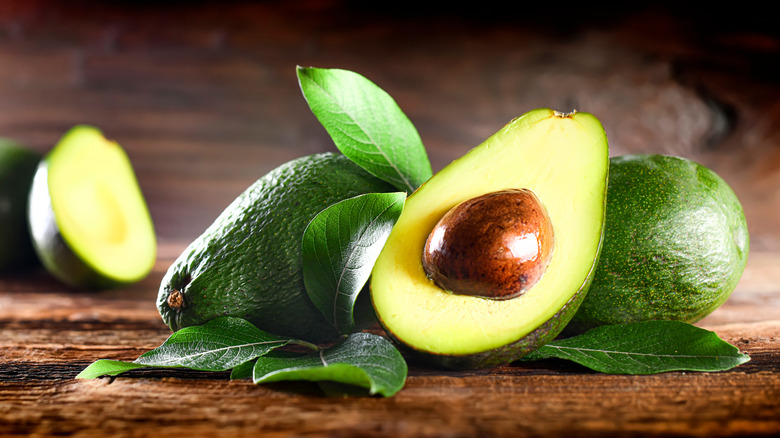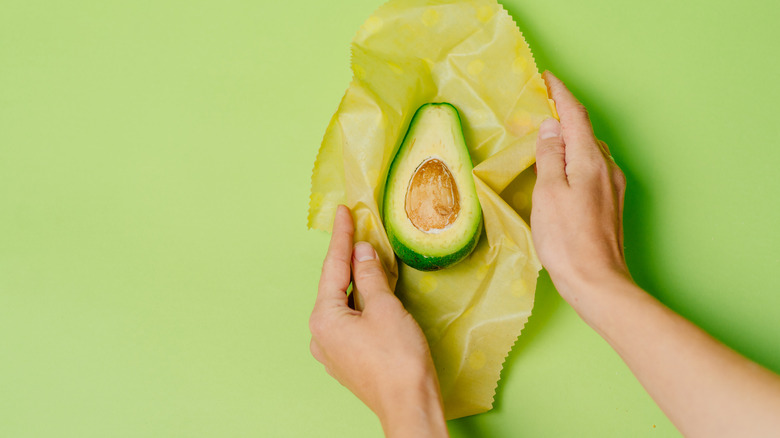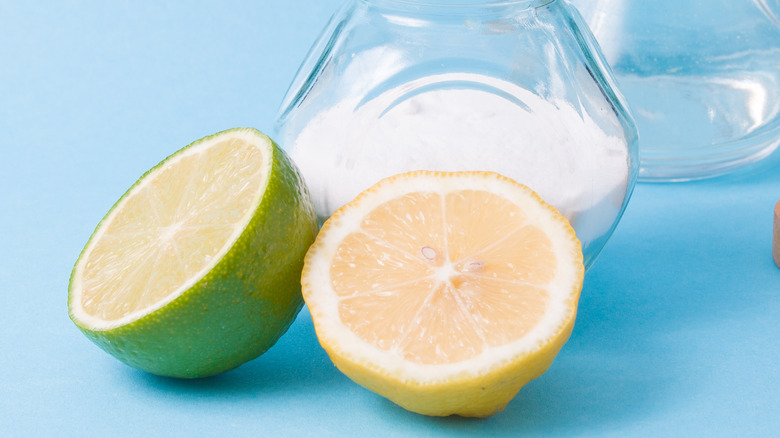The Best Way To Store Cut Avocado
We're beginning to think avocados have grown sentient and know how popular they've become. Why else would they be so exacting as to insist on a five-minute ripeness window and then promptly convert to gray mush? But all jokes aside, this trendy fruit is persnickety when it comes to maturation. Many shoppers even avoid buying avocados on sale since they're probably past their prime by the time the sale sticker hits.
And even when you hit the sweet spot of ripeness, the dilemma on all our avocado-fueled minds becomes: What's the best way to store an avocado after you cut it? A basic understanding of oxidation can help you there. Oxidation is simply the process of interacting with oxygen. In the case of avocados, the oxygen in the air combines with enzymes and substances naturally present in the avocado flesh to create that nasty browning soon after you cut it.
The best way to prevent browning is to limit your avocado's contact with air with special air-tight containers, plastic wrap, or oil. Second, to combat the oxidizing process, you'll need an antioxidant (as in, anti-oxidizer) and/or acid to slow down the effects of oxygen upon the fruit's natural enzymes.
Minimize oxidation by covering tightly
To prevent avocado browning, minimizing air exposure is key. Plastic wrap probably comes to mind first, and for good reason: it's handy in almost every kitchen, inexpensive, and allows for close contact with the flesh to keep out air. But another option is a container designed specifically for avocados. These may be too single-function for the multitasker cooks among us, but if you eat avocados often — and you have the kitchen storage space — these little cases may be worth the small investment.
Another unusual but convenient option to avert air exposure to your avocado is olive oil. Drizzle it over the flesh to coat and wipe it off gently before eating. This comparison of ways to store cut avocado gave olive oil the gold star over lemon juice or the avocado containers in keeping the fruit fresh. The result likely stems from olive oil acting as an airtight block, like a delicious liquid plastic wrap covering every surface evenly. Preventing air exposure is better than combating the oxidation afterward with an acid like lemon juice.
Acid adds an extra protective punch
Speaking of acids, they represent the other side of the coin in storing cut avocado. Acids prevent avocado browning by interfering with the enzymatic activity in the flesh. Also, some acids (like ascorbic acid in lemon and lime juice) act as an antioxidant to block oxidation once it begins.
Don't assume lemon or lime juice are the only acid game in town. This writer personally loves a hint of vinegar (balsamic, to be exact) to slow down oxidative browning while adding some zing. Of course, dark-colored vinegars give you a different kind of browning from the vinegar's hue so you may prefer white distilled or white wine vinegar instead. You can safely get up to 3 more days of edibility if you adequately cover and acid-treat your leftover avocados, so the extra time and effort will be well compensated in saving money and preventing food waste.
But after all that, what if you've missed the mark and your little guy has started turning dark? Of course, you can't go wrong with fresh homemade guacamole, but you could also get a little more creative with this avocado crab salad. If the color is too unappetizing for those options, though, you could also pop the avocado chunks in the freezer. Some ways to use frozen avocado include adding it to smoothies to increase creaminess or blending it into a soup base for richness. Your heart and taste buds will approve.


